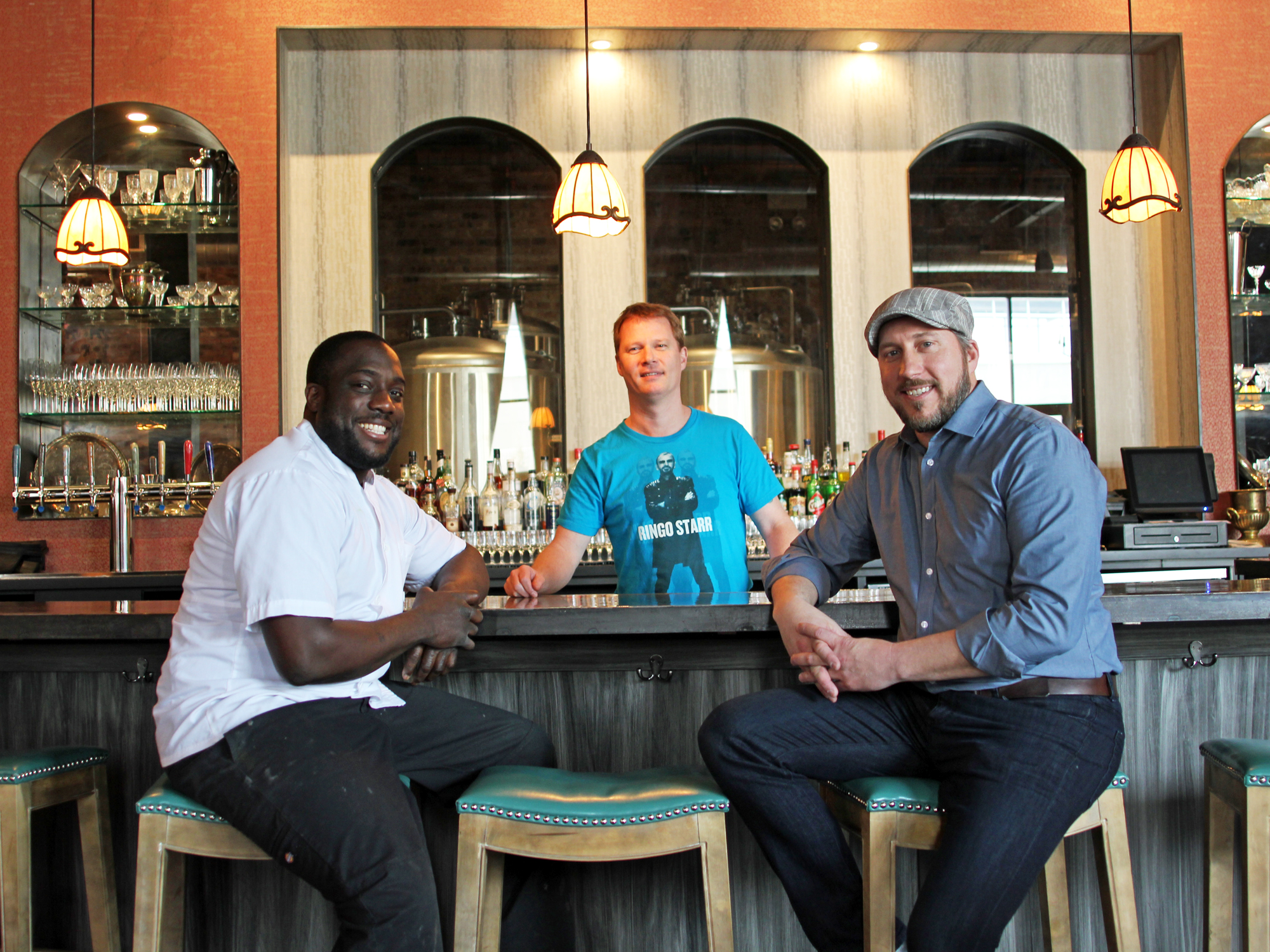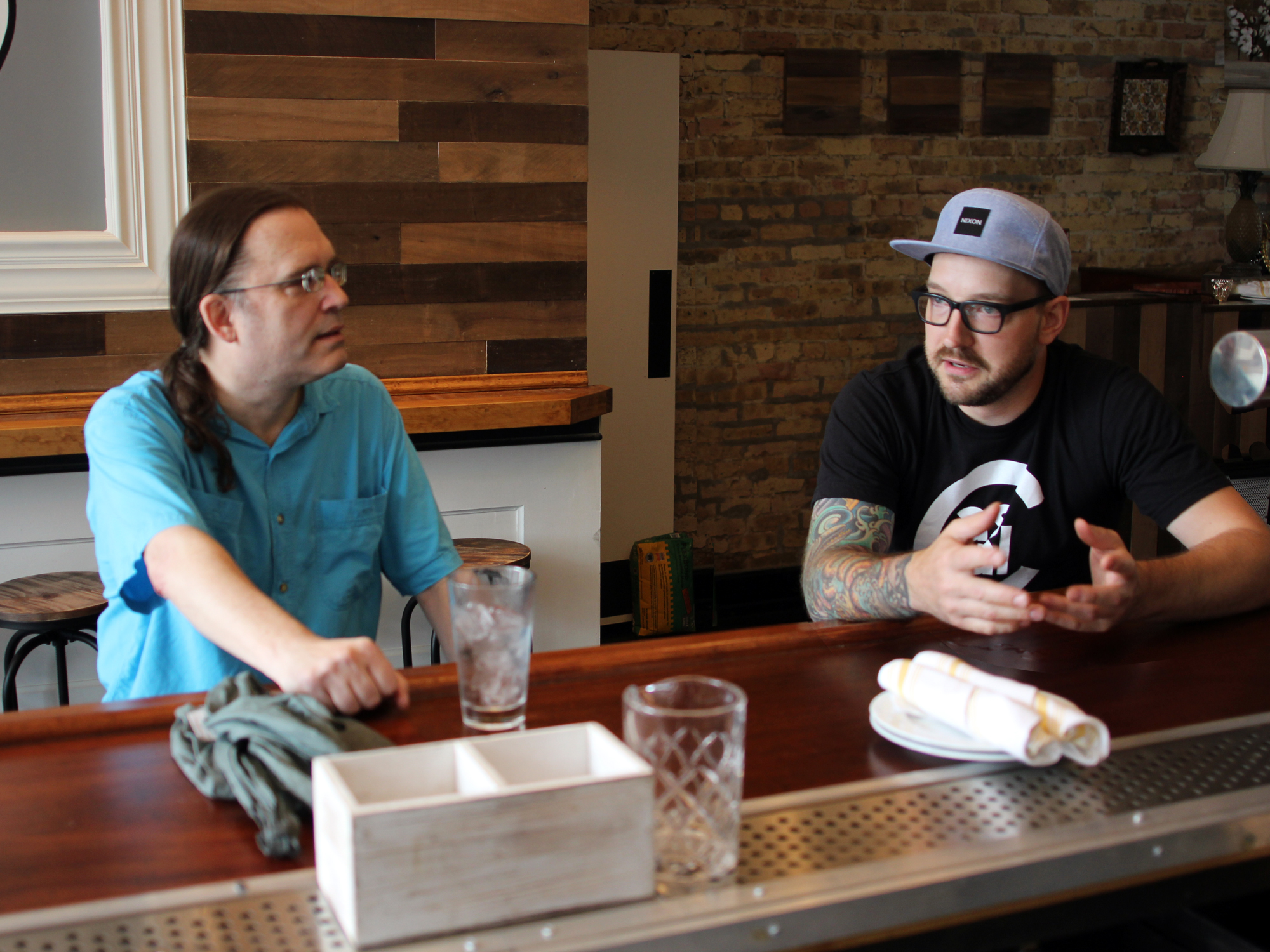WORKING AT OLD HABITS, THE KITCHEN INSIDE Ludlow Liquors in the former Orbit Room space in Avondale, Nick Jirasek aims to serve Chicago blue collar food, not to elevate it. At least not in the sense of plopping foie gras on anything, or using sirloin in place of some cut a working man could afford; his menu consists of things you’d be happy noshing on while watching a game, from South Side-style rib tips to a bowl a’ mostacciol’.
“What I’m really trying to do is highlight Chicago blue collar food through a creative lens, but not ‘elevate’ it at all,” Jirasek says. “We’re just using some cheaper cuts and putting a lot of time into them. It’s all very straightforward, they’re all things that I’ve been eating for my entire life here. It’s not healthy, but it’s not unhealthy either, we’re not giving giant portions of anything.”
“If I gave any of this to the union plumber who lives upstairs, he wouldn’t think that I was trying to big time him,” he says.
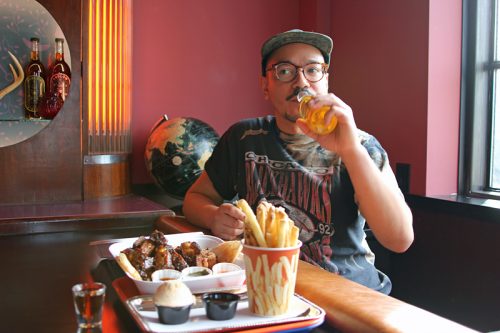
Chef Nick Jirasek
Jirasek—everyone calls him that, pronouncing it like the dinosaur park—has been a Facebook friend of mine for some years (for a relatively low-profile cook, his food world contacts are wide and unmistakably plugged-in), and we’ve talked Chicago Asian food a couple of times by instant message. (Like a lot of savvy younger chefs, he’s part Filipino.) But we’d never actually met until I swung by the newly opened Ludlow Liquors, whose first act of Chicago cultural preservation was updating the drink offerings while not losing the atmosphere of a working man’s corner bar.
It quickly becomes clear that Jirasek is fluent on the history of regular guy foods—one dish on his short menu is inspired by a vintage LTHForum favorite, long gone, called the Depot Diner, and he launches easily into a spiel about his style of Chicago barbecue that seems well acquainted with the smoked meat literature: “One of the things that’s interesting to me is that on the north side, no one does mild sauce, no one does rib tips at all. You can’t get them up here. So we have a mild sauce that we make from scratch—I put coffee in it because I like the way that the kind of smoky flavor marries with that.”
“I think anyone who grew up eating the food that’s on the menu, they would give ours the thumbs-up,” Jirasek says. “I think it fits really well in this kind of bar setting. It shows both ends of the spectrum, it can be really thoughtful and artisanal, but at the end of the day, it’s just food. I have a deep love for Chicago food traditions, and just want to bring those to light for people who aren’t necessarily from here, and may not be looking for them.”
LUDLOW LIQUORS IS OWNED BY Wade McElroy and Jeff Donahue (Sportsman’s Club, Estereo), and McElroy says they nabbed the bar because the old owners were retiring to move to Wisconsin. “We met them and really hit it off, and let them know our intentions to run Orbit Room through the end of the year, and then make something more personal to myself and my partner Jeff.”
“We wanted to have stirred cocktails as the focus of the menu,” he says, with a strong line in classics like sours and highballs—but at the same time, without losing the straightforward beer-and-a-shot pleasures. As for food, “We knew definitely what we wanted to do with the bar and the aesthetic, but we’re bar folks through and through, we haven’t really spent time in the kitchen. We knew Jirasek, and we knew Eric [Valdivia, Jirasek’s collaborator in the kitchen], and we wanted the opportunity to put something dynamic into this space that would have its own identity and its own creative process.”
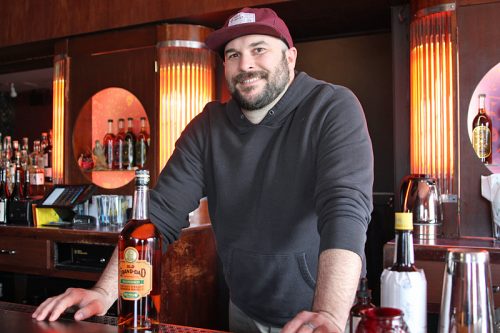
Wade McElroy, co-owner of Ludlow Liquors
I ask why they chose to have two different names for the bar and the kitchen. “Old Habits isn’t about us, it’s about Jirasek and Eric and their vision,” he says. “It was important to us that if they’re going to exist in this space with us, to have the opportunity to carry their own brand.”
That brand is unmistakably easy-to-like food in a bar setting, nothing too out there—or expensive. “It’s priced in a way that it’s not pricing anyone out,” Jirasek adds. “I think that’s where Ludlow and Old Habits have a similarity, in that we are deft in our craft, and we know what we’re doing, but really at the end of the day, you can get a shot and a beer here, not just a beautifully crafted cocktail. Everything we make comes out in a paper food tray on a dollar store plastic tray.”
“It just comes out like… a dream,” he says, taking an unexpected metaphysical turn. “Like a slightly augmented version of what you would get at a stand on the street,” he adds. Revealing, if there had been any doubt, that his dreams are much like my own.
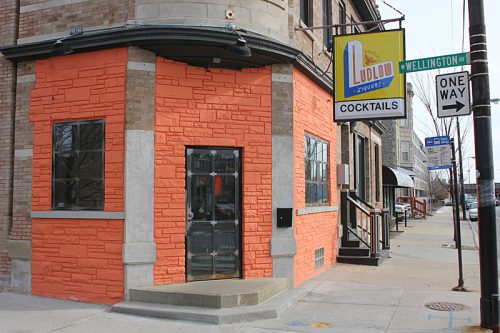 “I WAS BORN AND RAISED IN OAK PARK, and then I moved out the second I could,” he laughs. “The second you can hop on the El, you start searching all around the city. That’s some of my fondest memories growing up.”
“I WAS BORN AND RAISED IN OAK PARK, and then I moved out the second I could,” he laughs. “The second you can hop on the El, you start searching all around the city. That’s some of my fondest memories growing up.”
Jirasek got his start in food, he says, when he went to an art opening and saw that there were always things to eat. So he started a company called Guerrilla Smiles, making snacks for his artist friends’ events. He’s worked around a bit, including at Theaster Gates’ Currency Exchange Cafe in Hyde Park—which solves a mystery. In a recent review, Mike Sula mentioned that the current chef had “kept” soul food greens cooked in Mexican Topo Chico mineral water on the menu. But if he was keeping them, who had come up with them?
“Originally I had beer in the greens, which was because I had beer in the back,” Jirasek explains. (They didn’t have a liquor license, so they couldn’t serve it.) “So the second I ran out of beer, I said, well, we still have Topo Chico. It’s really great—I feel like it helps soften them, and adds this kind of minerality to them.”
More recently, “I was at Gaslight Coffee Roasters, that was really helpful in figuring out how to source, and how to become familiar with what people want and experiment with some ideas of what food means to me, and to this new influx of people coming to Chicago.”
We’re just kind of taking things and leaving them at the same point where they are, and then putting our own mark on it.
I ask him what he means by that. “I think the people who are moving into the north side or the near west side, what they’re looking for is different from what people who are from here are looking for.” To his mind, neighborhoods with lots of transplants are “a little more coastal in their ideas—maybe two or three or four year old coastal ideas. It’s like trend chasing to a certain extent, fewer chefs sticking to one thing and instead trying what they’ve seen that works.”
But if you think your audience is people who moved to Chicago from these other places, it seems odd to chase them with classic Chicago foods, which seems to be slowly fading away throughout the city. “Well, that’s my fear,” he says. “You will see certain homages to that kind of food on nicer menus. That’s where I wanted to see that we weren’t elevating anything, but just kind of taking things and leaving them at the same point where they are, and then putting our own mark on it.”
In the end, he’s a historical preservationist, working out of the kitchen in the back of a corner bar in Avondale. “I’m really worried that Chicago’s losing its identity,” he says. “And that’s why, in some ways, I’m trying to stake out my way of thinking about Chicago’s identity, and its food.”
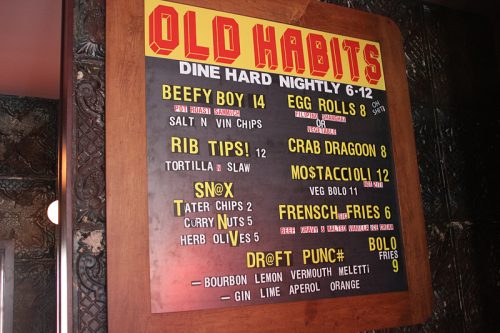
Chef Nick Jirasek’s Reinvented Chicago Menu, In His Words
Beefy Boy (pot roast sammich): Pot roast is the definition of comfort food. This is based on the Depot Diner’s pot roast sandwich, I’ve never seen it anywhere else to be honest. We would go there once a week to get his pot roast sandwich and his fresh-made doughnuts. When it was closing we were bemoaning it so much, because where else can you get that sandwich?
We use some brisket, and one of the things I’m really into is cheek meat. Cheeks can be a little bit much on their own, so we’re cutting the cheeks with some nice beautiful long strips of braised brisket, and then we take the braising liquid and boil it down to make this beautiful gravy, that we serve with all the French fries.
Chicago Rib Tips: We use 100% applewood. We rub the tips in Plochman’s Mustard—there’s a lot of trying to use classic Chicago ingredients, not Green City Market local stuff but things that every person who says “to da Jewels” would be eating. For a rub, we use just celery salt, cayenne pepper, onion powder and garlic powder.
We take the tip cut and we do that for four hours—I feel like we take a little longer than a lot of places that do them at a higher temperature. At Peoria Packing there’s this really cool cut which I had never seen before, called the belly tip—basically a rib tip with some belly meat on it, and they leave the skin on. We played around a little bit with it, and honestly with the skin on it can get a little bit gummy. So what we do is, we smoke that separately for about six hours. And then, on the pickup, we fry those. So we get these nice, crispy bites, almost like carnitas and chicharron.
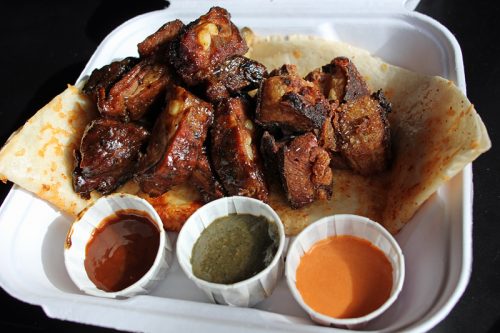
Then we take the rib bones off the tips and throw them in a stock pot for three days, and it comes out this black, straight up squid-ink jus or stock. So then on the pickup we throw the tips in there, and you get this beautiful, naturally smoky sauce on the rib tips with the crunchy belly tips. And rather than serving it with a piece of white bread underneath, we have a flour tortilla that we put a bunch of Sarvecchio [a parmesan-style cheese from Wisconsin] on, on the flat top, and then serve the tips on top of that. So it’s an homage to both barbecue and taquerias, because we serve it with the mild sauce and there’s a verde that we serve with it as well that’s coriander and tomatillo based, almost a chutney. Red and green sauce.
Filipino Egg Rolls: I knew that I wanted to put some Filipino stuff on the menu, just because it’s not necessarily something that gets shown a lot, and I think lumpia are really appropriate for a bar setting, because they’re a little smaller, a little bit more shareable, and it’s just pretty much straight up meat—there’s no cabbage or filler.
One of the ubiquitous Filipino ingredients is Spam, and I thought it was a perfect marriage of the normal pork or beef filling that would be in lumpia. The Spam, mixed with patis [fish sauce]—we’re not even putting any salt in the dish. We serve it on the side with the traditional spiked vinegar, with garlic and ginger, and then also—I guess it’s technically a hot sauce, but I just call it hot vinegar. We have more sauces than menu items, I love playing with sauces.
Crab Dragoon: Some Filipino restaurants have crab rangoon, but we’re not trying to do straight up Filipino food—we’re just taking things that we want to eat at a bar and putting our own spin on them. We put Everything cream cheese inside it—it has what’s on an Everything bagel—and we’re using a really good crab and whitefish mixture, and then covering it in popcorn “butter,” movie theater buttery topping, that’s steeped in a bunch of garlic.
Vegetarian Eggrolls: We’re kind of flipping these around seasonally. Right now of course there’s not a lot of vegetables going on, so we’re just using mushrooms with noodles and bok choy. I’m treating it like a cumin and lamb dish—a whole lot of cumin, a whole lot of chili, sesame oil, kale and bok choy to fill it out in kind of a green, somewhat healthy way.
Mostaccioli (Not Ziti) Bolognese/Veggie Bolo: I don’t think anyone who’s not from Chicago even knows what mostaccioli is, but literally that’s what every kid who’s from around here grows up eating. It’s on every buffet line, chicken mostaccioli.
We make a bolognese sauce with a flavor base of guanciale, so it’s kind of a traditional bolognese. But the gianciale we get is from Smoking Goose, and it has a ton of wine flavor. So we add wine to accentuate that flavor.

And then, because we have it, we make a vegetarian version with so much mushroom in it, we wanted it to taste very savory and deep and kind of like… death, in the same way meat does.
Frensch Cut Fries: Potatoes are probably my favorite food, and these fries are kind of a technique that I’ve been building throughout the years. Everybody knows the blanch, blanch fry, or blanch, fry, fry three step methods. I’ve always been trying to augment that in some way.
So what we do is, we salt cure them, we throw a ton of salt on them and let them sit for about 30 minutes at room temperature, so some of the moisture starts popping out. Then we hit it with a little bit of white vinegar, so it starts activating the starches. And then we cover it in cold water and let it sit overnight. We coat them in potato starch and fry them, and they come out just like if you’d done the blanch blanch fry method, and actually crispier on the outside. They’re so crazy crunchy on the outside, and then mashed potato-ey on the inside.
Then we had all this gravy, it comes on the pot roast sandwich, but then we’re like, what are we going to do with all this gravy? I’m thinking, I love gravy on my fries, but I’m not going to throw it on there and try to shoehorn poutine into the whole situation. We’ll just give people a side of gravy with their fries, and then I really wanted to evoke that memory of people dipping their fries into their Frosty at Wendy’s. My cousin actually has Black Dog Gelato, so I called her up right after I had the idea and she was like, “It’s 20 degrees outside, Nick, I’m not making gelato right now.” So in the meantime we’re using whatever gelato we have, and malting it ourselves.
Michael Gebert brings the gravy and the ice cream as editor of Fooditor.
Latest
Join the Discussion
After you comment, click Post. If you're not already logged in you will be asked to log in or register with Disqus.





